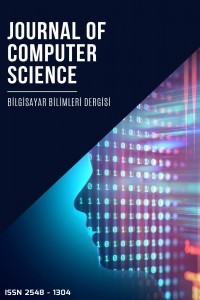Madde Tanıma Sistemlerinde Makine Öğrenmesi Metotlarının Kullanımı
Yapay Sinir Ağı, Derin Öğrenme, Makine Öğrenmesi, Optik Sensörler, YOLO
Utilization of Machine Learning Methods in Substance Recognition Systems
Artificial Neural Network, Deep Learning, Machine Learning, Optical Sensors, YOLO,
___
- Asheri Arnon, T., Ezra, S., & Fishbain, B. (2019). Water characterization and early contamination detection in highly varying stochastic background water, based on Machine Learning methodology for processing real-time UV-Spectrophotometry. Water Research, 155, 333–342. https://doi.org/10.1016/j.watres.2019.02.027
- Bajaj, N. S., Patange, A. D., Jegadeeshwaran, R., Pardeshi, S. S., Kulkarni, K. A., & Ghatpande, R. S. (2023). Application of metaheuristic optimization based support vector machine for milling cutter health monitoring. Intelligent Systems with Applications, 18(February), 200196. https://doi.org/10.1016/j.iswa.2023.200196
- Bridgeman, J., Baker, A., Brown, D., & Boxall, J. B. (2015). Portable LED fluorescence instrumentation for the rapid assessment of potable water quality. Science of the Total Environment. https://doi.org/10.1016/j.scitotenv.2015.04.050
- Dubreuil, M., Delrot, P., Leonard, I., Alfalou, A., Brosseau, C., & Dogariu, A. (2013). Exploring underwater target detection by imaging polarimetry and correlation techniques. Applied Optics. https://doi.org/10.1364/AO.52.000997
- Kavakiotis, I., Tsave, O., Salifoglou, A., Maglaveras, N., Vlahavas, I., & Chouvarda, I. (2017). Machine Learning and Data Mining Methods in Diabetes Research. Computational and Structural Biotechnology Journal, 15, 104–116. https://doi.org/10.1016/j.csbj.2016.12.005
- Lyu, Y., Chen, J., & Song, Z. (2019). Image-based process monitoring using deep learning framework. In Chemometrics and Intelligent Laboratory Systems (Vol. 189). Elsevier B.V. https://doi.org/10.1016/j.chemolab.2019.03.008
- Mhaskar, H. N., Pereverzyev, S. V., & van der Walt, M. D. (2017). A Deep Learning Approach to Diabetic Blood Glucose Prediction. Frontiers in Applied Mathematics and Statistics, 3(July), 1–11. https://doi.org/10.3389/fams.2017.00014
- Piederrière, Y., Boulvert, F., Cariou, J., Le Jeune, B., Guern, Y., & Le Brun, G. (2005). Backscattered speckle size as a function of polarization: influence of particle-size and- concentration. Optics Express, 13(13), 5030. https://doi.org/10.1364/opex.13.005030
- Potansiyeli Görmek - Google. (n.d.). Retrieved July 24, 2023, from https://about.google/intl/tr_zz/stories/seeingpotential/
- Sayato, Y. (1989). WHO Guidelines for Drinking-Water Quality. Eisei Kagaku, 35(5), 307–312. https://doi.org/10.1248/jhs1956.35.307
- Skadsen, J., Janke, R., Grayman, W., Samuels, W., Tenbroek, M., Steglitz, B., & Bahl, S. (2008). Distribution system on-line monitoring for detecting contamination and water quality changes. Journal / American Water Works Association, 100(7), 81–94. https://doi.org/10.1002/j.1551-8833.2008.tb09678.x
- Wang, H., Hu, H., Jiang, J., Li, J., Li, X., Zhang, W., Cheng, Z., & Liu, T. (2021). Polarization differential imaging in turbid water via Mueller matrix and illumination modulation. Optics Communications, 499(June), 127274. https://doi.org/10.1016/j.optcom.2021.127274
- Yacouby, R., & Axman, D. (2020). Probabilistic Extension of Precision, Recall, and F1 Score for More Thorough Evaluation of Classification Models. https://doi.org/10.18653/v1/2020.eval4nlp-1.9
- Zulkifli, S. N., Rahim, H. A., & Lau, W. J. (2018). Detection of contaminants in water supply: A review on state-of-the-art monitoring technologies and their applications. Sensors and Actuators, B: Chemical, 255, 2657–2689. https://doi.org/10.1016/j.snb.2017.09.078
- ISSN: 2548-1304
- Yayın Aralığı: Yılda 2 Sayı
- Başlangıç: 2016
- Yayıncı: Ali KARCI
Sayısal Global Optimum için Çift-Girişim Tabanlı İyileştirme Algoritmasının Yakınsama Analizi
İrfan SARIYILDIZ, Mehtap KÖSE ULUKÖK
Transformer Kodlayıcı ve Zaman-Frekans Görüntüleri Kullanarak Otomatik Uyku Evreleri Sınıflandırması
Yeşil Tedarikçi Seçiminde Hibrit Bulanık AHP ve Bulanık QFD Yaklaşımının Kullanılması
Candan UÇKUN, Nurdan DALGIÇ, Aytaç YILDIZ
Sağlık Hizmetindeki Robotlar İçin Blokzincir Destekli Görev Yönetimi: Webots Simülasyonu
Mehmed Oğuz ŞEN, Fatih OKUMUŞ, Fatih KOCAMAZ
Muhammed Salih TATAR, Rabia KÖK, Aybars UGUR
Aralık Tip-2 Bulanık TOPSIS Yöntemi Kullanılarak Çalışan Performansının Değerlendirilmesi
Elma Yaprağı Hastalıklarının AlexNet Kullanılarak Derin Öğrenme Tabanlı Sınıflandırılması
Felix Olanrewaju BABALOLA, Nekabari Isabella KPAİ, Önsen TOYGAR
Fonolojik Hataların Değerlendirme Metriklerindeki Rolü
Ayşegül ÇAĞLI, Vakkas KARAKURT, Kürşat Edabalı YILDIRIM, Fatih SOYGAZİ, Yılmaz KILIÇASLAN
Siber Güvenlikte T-Pot Honeypot Uygulanması: Kurumsal Ağ Üzerinde Örnek Durum Çalışması
